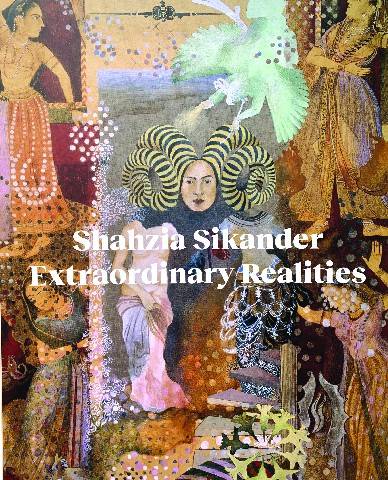
There are many ways to live and prisms to make sense of life as we see it. Writers process the world through words, scientists through science, gardeners through botany and artists through the visual depiction of how things are. No one way is ‘right,’ no one way is ‘wrong’ – but it is interesting to observe how one can make sense of the world.
I have always remembered how Shahzhia Sikander’s final thesis work at the NCA made sense of her world in Lahore – using the traditional Mughal miniature, but making it her own. She was an onlooker and maintained a sense of self though part of the mosaic of different aspects of life in Lahore – a muhalla depicting the various forms and ways of life. In a way, it resembles the old Japanese prints which also showed normal everyday scenes, which, now seen in a historical context, are a portal into history. I wonder how that piece of art would be seen in a historical context when that way of living has disappeared. Will art historians peer into this as a history of how Lahore used to be?
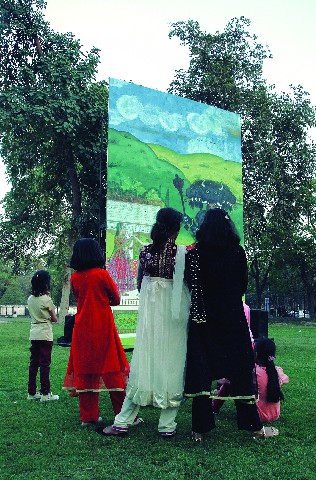
Thankfully modern technology allows us to capture history, narrative and arts simultaneously and whether one is living in Lahore or New York, one can access Sikander’s latest retrospective ‘Extraordinary Realities’ at the Morgan library with a few clicks of a computer. The result is a visual kaleidoscope of the narrative of one of the leading Pakistani American artists but also a journey into her narrative and story over the last two decades. It is not easy being an pioneer or breaking new ground. It is practically impossible to continue to do this over the span of decades. For to do so, one has to break out of a comfort zone and to challenge oneself – with new mediums, ways of doing things and to test and challenge oneself. For excellence is now going beyond the technical aspect of one’s craft to wander into new unexplored territory.
We did some college virtual tours this summer – more to explore different campuses and the world of academia. One college pointed out its observatory and that it stayed open all night for people to consider the universe and galaxy. It was there that one budding scientist discovered Pluto. Stephen Hawkings reminded us of that fact, i.e. one must always remember to look up at the stars and not down at one’s feet – and wonder about what makes the universe exist. It is a call for curiosity: and that advice is often ignored. We are often very comfortable in what we are doing and as we age, we settle into habits and routines and comforts. It is difficult to grow and emerge from your comfort zone.
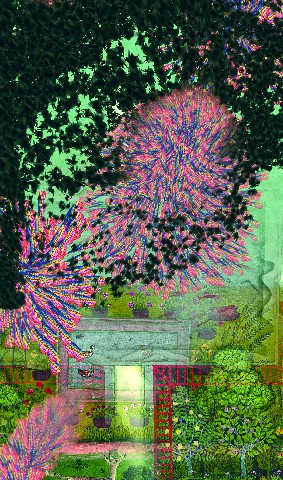
I would imagine that it is even harder to create and be consistently creative over a period of time, for it means to constantly be in learning mode. That is the quality I have long admired with Sikander’s efforts – to experiment with different media – whether digital, or installations, or, now in this exhibition, sculpture and paintings. One has to keep asking questions and explore the world around us. The journey of an artist, in particular, has to be multidisciplinary, drawing from the world around us and the world within, the science and technical skills associated with mixing and painting, the imagination which leads to an end goal as well as the experimentation required to make something unique and new.
The journey is even more complicated by the evolution of the art world. It has evolved into its own industry with an estimated worth of almost US $50-100 billion. The value is associated with artists who have brand recognition rather than what is produced. Staying one’s own course and maintaining artistic integrity is a challenge – much as it can be in many professions. Think about modern-day Hollywood blockbusters of comic book heroes (will they ever run out of comic book characters?) versus issues-based movies, particularly those that make us uncomfortable, whether about race or caste or inequality.
The art world has also not escaped digitalization. Like other industries, the digitalization of art has changed what is considered art and democratized the availability of it. The recent block chain phenomenon has not eluded art either – with the recent development of block chain digital art market places such as R.A.R.E., offering artists a new mechanism and market to sell their art. The mind boggles at all these new inventions – whether augmented reality, virtual reality or technology that blurs the world between real and virtual. It is an interesting concept when one thinks about it – that art depicts a virtual world in any case, and technology allows us to digitally experiment.
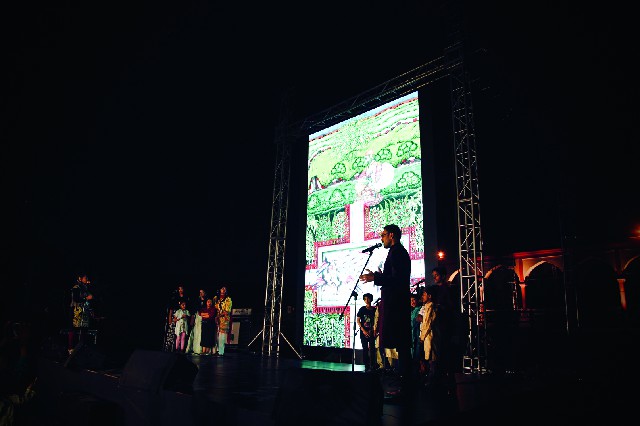
For those not familiar with this, check out Sikander’s collaboration with Chinese composer Du Yun: now a permanent exhibit in the Philadelphia museum of Art – ‘Disruption as Rapture,’ which combines the miniature being broken down into flying birds and recomposing again.
The retrospective is a visual reminder of how Sikander has deconstructed traditional images and visuals over time – and exploring themes which matter, whether gender, race, class or history. It traces her journey over time from NCA in the late 1980s to Rhode Island, a period of two years in Houston and her final destination of New York since 1997. One can look at the tour online and even organize virtual class tours, which should make it more accessible for Pakistani students.
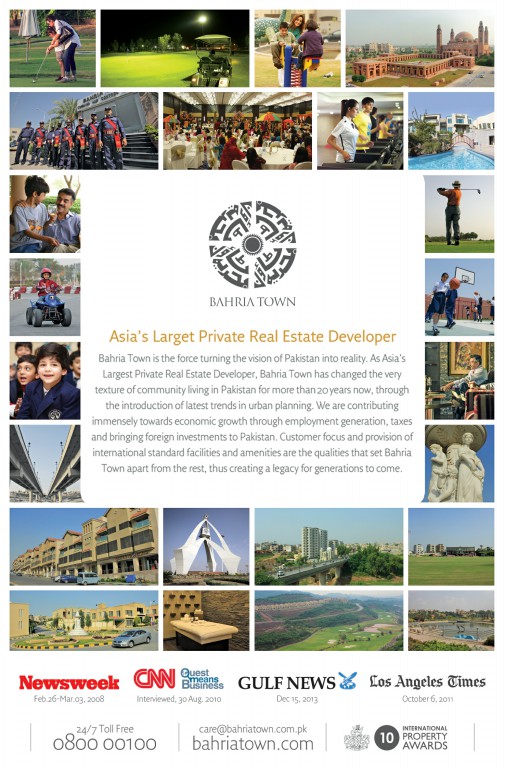
Art is often dismissed in our system of education as a lighter subject – it does not fit with the value and privilege which is given to doctors or nuclear scientists. A recent BBC documentary profiled a group of Nobel Laureate scientists in an attempt to ascertain what the similarities were. The one common characteristic between them was curiosity. It has been scientifically proved that art helps develop problem-solving skills and pushes one to innovate, explore their world and even create a world of their own making. These values are those for the 21st century!
And for this to happen, one has to pay tribute and gratitude to artists like Sikander, whose curiosity and learnings can share the light for those of us who have forgotten our childhood curiosity. So next time, pick up a paint brush or encourage those around you to do it – for who knows where that may disrupt and augment your own reality?
I have always remembered how Shahzhia Sikander’s final thesis work at the NCA made sense of her world in Lahore – using the traditional Mughal miniature, but making it her own. She was an onlooker and maintained a sense of self though part of the mosaic of different aspects of life in Lahore – a muhalla depicting the various forms and ways of life. In a way, it resembles the old Japanese prints which also showed normal everyday scenes, which, now seen in a historical context, are a portal into history. I wonder how that piece of art would be seen in a historical context when that way of living has disappeared. Will art historians peer into this as a history of how Lahore used to be?

Thankfully modern technology allows us to capture history, narrative and arts simultaneously and whether one is living in Lahore or New York, one can access Sikander’s latest retrospective ‘Extraordinary Realities’ at the Morgan library with a few clicks of a computer. The result is a visual kaleidoscope of the narrative of one of the leading Pakistani American artists but also a journey into her narrative and story over the last two decades. It is not easy being an pioneer or breaking new ground. It is practically impossible to continue to do this over the span of decades. For to do so, one has to break out of a comfort zone and to challenge oneself – with new mediums, ways of doing things and to test and challenge oneself. For excellence is now going beyond the technical aspect of one’s craft to wander into new unexplored territory.
I would imagine that it is even harder to create and be consistently creative over a period of time, for it means to constantly be in learning mode. That is the quality I have long admired with Sikander’s efforts
We did some college virtual tours this summer – more to explore different campuses and the world of academia. One college pointed out its observatory and that it stayed open all night for people to consider the universe and galaxy. It was there that one budding scientist discovered Pluto. Stephen Hawkings reminded us of that fact, i.e. one must always remember to look up at the stars and not down at one’s feet – and wonder about what makes the universe exist. It is a call for curiosity: and that advice is often ignored. We are often very comfortable in what we are doing and as we age, we settle into habits and routines and comforts. It is difficult to grow and emerge from your comfort zone.

I would imagine that it is even harder to create and be consistently creative over a period of time, for it means to constantly be in learning mode. That is the quality I have long admired with Sikander’s efforts – to experiment with different media – whether digital, or installations, or, now in this exhibition, sculpture and paintings. One has to keep asking questions and explore the world around us. The journey of an artist, in particular, has to be multidisciplinary, drawing from the world around us and the world within, the science and technical skills associated with mixing and painting, the imagination which leads to an end goal as well as the experimentation required to make something unique and new.
The journey is even more complicated by the evolution of the art world. It has evolved into its own industry with an estimated worth of almost US $50-100 billion. The value is associated with artists who have brand recognition rather than what is produced. Staying one’s own course and maintaining artistic integrity is a challenge – much as it can be in many professions. Think about modern-day Hollywood blockbusters of comic book heroes (will they ever run out of comic book characters?) versus issues-based movies, particularly those that make us uncomfortable, whether about race or caste or inequality.
The retrospective
is a visual reminder of how Sikander has deconstructed traditional images
and visuals over time
The art world has also not escaped digitalization. Like other industries, the digitalization of art has changed what is considered art and democratized the availability of it. The recent block chain phenomenon has not eluded art either – with the recent development of block chain digital art market places such as R.A.R.E., offering artists a new mechanism and market to sell their art. The mind boggles at all these new inventions – whether augmented reality, virtual reality or technology that blurs the world between real and virtual. It is an interesting concept when one thinks about it – that art depicts a virtual world in any case, and technology allows us to digitally experiment.

For those not familiar with this, check out Sikander’s collaboration with Chinese composer Du Yun: now a permanent exhibit in the Philadelphia museum of Art – ‘Disruption as Rapture,’ which combines the miniature being broken down into flying birds and recomposing again.
The retrospective is a visual reminder of how Sikander has deconstructed traditional images and visuals over time – and exploring themes which matter, whether gender, race, class or history. It traces her journey over time from NCA in the late 1980s to Rhode Island, a period of two years in Houston and her final destination of New York since 1997. One can look at the tour online and even organize virtual class tours, which should make it more accessible for Pakistani students.

Art is often dismissed in our system of education as a lighter subject – it does not fit with the value and privilege which is given to doctors or nuclear scientists. A recent BBC documentary profiled a group of Nobel Laureate scientists in an attempt to ascertain what the similarities were. The one common characteristic between them was curiosity. It has been scientifically proved that art helps develop problem-solving skills and pushes one to innovate, explore their world and even create a world of their own making. These values are those for the 21st century!
And for this to happen, one has to pay tribute and gratitude to artists like Sikander, whose curiosity and learnings can share the light for those of us who have forgotten our childhood curiosity. So next time, pick up a paint brush or encourage those around you to do it – for who knows where that may disrupt and augment your own reality?

